

Ladder of inference. Brenda Vandermeulen Handling Difficult Conversations. Pinterest. Test Your Assumptions and Inferences - Roger Schwarz & Associates, Inc. Assumptions trip us up even when we’re acting in the best of faith.

In the O. Henry short story “The Gift of the Magi,” Delia and Jim Young are a young married couple with very little money. On the day before Christmas, Delia cuts her long beautiful hair and sells it for making a wig, so that she can buy Jim a platinum chain for his prized pocket watch. Meanwhile, Jim sells his pocket watch to buy Delia a beautiful set of combs for her flowing, knee-length hair. The story has intrigued me since I first read it as a teenager.
Assumptions and inferences. Assumptions are things we take for granted. The problem isn’t that we make assumptions and inferences. In my experience, untested inferences are one of the main reasons that one on one and group conversations unravel. To test inferences productively, you need to do two things: Rethinking Thinking Using the Ladder of Inference. In today’s fast-moving world, you are under pressure to act swiftly rather than spend time understanding the facts and reasoning things through.
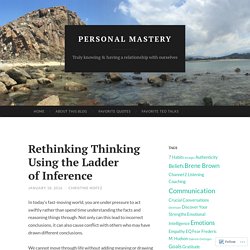
Not only can this lead to incorrect conclusions, it can also cause conflict with others who may have drawn different conclusions. We cannot move through life without adding meaning or drawing conclusions but you can improve your communication through reflection and using the “Ladder of Inference” in three ways: Becoming more aware of your own thinking and reasoning: AKA reflection.Making your thinking and reasoning more visible to others: AKA advocacy.Inquiring into other’s thinking and reasoning: AKA inquiry. Actions and decisions should be founded in reality so when you accept or challenge other people’s conclusions, you need be confident that their reasoning, and yours, is firmly based upon accurate facts.
The ladder of inference. Jumping to conclusions, part 2: correct answers to the Cash Register Test. Last week I posed a challenge to my readers: to have a go at “The Cash Register Exercise“, an uncritical inference test.
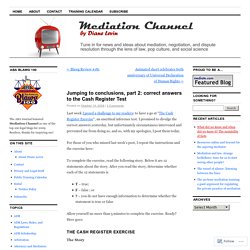
I promised to divulge the correct answers yesterday, but unfortunately circumstances intervened and prevented me from doing so, and so, with my apologies, I post them today. For those of you who missed last week’s post, I repeat the instructions and the exercise here: To complete the exercise, read the following story. Below it are 12 statements about the story. The Ladder of Inference: Improve Communications and Relationships in the Workplace. Have you ever stopped to think about the things that you just inherently know and how you know them?
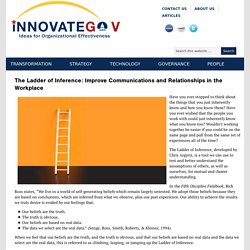
Have you ever wished that the people you work with could just inherently know what you know too? Wouldn’t working together be easier if you could be on the same page and pull from the same set of experiences all of the time? The Ladder of Inference, developed by Chris Argyris, is a tool we can use to test and better understand the assumptions of others, as well as ourselves, for mutual and clearer understanding.
In the Fifth Discipline Fieldbook, Rick Ross states, “We live in a world of self-generating beliefs which remain largely untested. We adopt those beliefs because they are based on conclusions, which are inferred from what we observe, plus our past experience. The Ladder of Inference. Climbing Down from Expert Bias – What's the PONT. The Ladder of Inference is a concept developed by the late Harvard Professor Chris Argyris, to help explain why people looking at the same set of evidence can draw very different conclusions.

The difference comes from the idea that, based on their beliefs, people ‘choose’ what they see in amongst a mass of information. More on that later, but first off, who fancies an experiment? If I was being a bit hipster I could claim it as a Randomised Control Trial (RCT if you are uber hipster), but I’ll stick to plain old ‘experiment’. Try this experiment at home or in the office: Go to twitter and find a hashtag for a recent conference or seminar where people have been busily tweeting,The topic doesn’t really matter, but something reasonably linked to your area of interest/business might be useful,Search on the hashtag so that you can see a good selection of tweets – about 100 will do,Copy the 100 tweets and paste them into a document.
Ladder of inference diagrams use pages 4 and 8 only. Ladder of Inference - Team Building Activities. Chris Argyris (1990) describes the progressive process of making observations, gathering information, making assumptions, and deciding action as being similar to climbing up on a "ladder of inference.

" This concept was later used by Peter Senge in The Fifth Discipline: The Art and Practice of the Learning Organization. Starting at the bottom of the ladder , we have reality and facts. From there, we: Experience these selectively based on our beliefs and prior experience. Interpret what they mean.Apply our existing assumptions, sometimes without considering them (heuristics).Draw conclusions based on the interpreted facts and our assumptions.Develop beliefs based on these conclusions.Take actions that seem "right" because they are based on what we believe. This can create a vicious circle. More Details, Examples and Activities Below Through his research, Argyris has discovered that every person has tendencies to climb up the ladder of inference too fast. 1.
References: Argyris, Chris (1990). BPM, Lean Six Sigma & Continuous Process Improvement. The Leadership Mind: The Ladder of Inference. The following was first presented to me by my good friend and mentor, Jim Boylan, PathFinders Consulting Alliance.
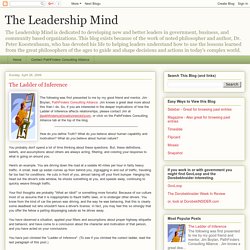
Jim knows a great deal more about this than I do. So, if you are interested in the deeper implications of how the Ladder of Inference affects relationships, please contact Jim at jbpathfinders(at)roadrunner(dot)com, or click on the PathFinders Consulting Alliance tab at the top of the blog. How do you define Truth? What do you believe about human capability and motivation? What do you believe about human nature? You probably don't spend a lot of time thinking about these questions. Here's an example. Your first thoughts are probably "What an Idiot! " ANZPA Journal 15 art09.
The Ladder of Inference - Infographic. Ladder lines. How to Bridge Differences using a Ladder of Inference. How to Bridge Differences using a Ladder of Inference Throughout our daily lives – both in professional and personal contexts – we experience differences of opinion with others.
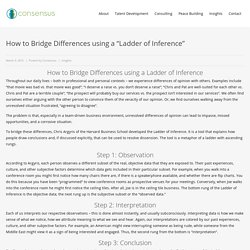
Examples include “that movie was bad vs. that movie was good”; “I deserve a raise vs. you don’t deserve a raise”; “Chris and Pat are well-suited for each other vs. Chris and Pat are a terrible couple”; “the prospect will probably buy our services vs. the prospect isn’t interested in our services”. We often find ourselves either arguing with the other person to convince them of the veracity of our opinion. Or, we find ourselves walking away from the unresolved situation frustrated, “agreeing to disagree”. The problem is that, especially in a team-driven business environment, unresolved differences of opinion can lead to impasse, missed opportunities, and a corrosive situation. The Ladder of Inference Creates Bad Judgment. Ladder of Inference. Short Circuiting Reality The following "Ladder of Inference" was, I believe, initially developed by Chris Argyris, and subsequently presented in Peter Senge's "The Fifth Discipline: The Art and Practice of the Learning Organization.
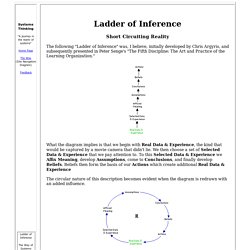
" What the diagram implies is that we begin with Real Data & Experience, the kind that would be captured by a movie camera that didn't lie. We then choose a set of Selected Data & Experience that we pay attention to. To this Selected Data & Experience we Affix Meaning, develop Assumptions, come to Conclusions, and finally develop Beliefs.
The blind spot. Rethinking thinking - Trevor Maber. An excellent way to better understand the Ladder of Inference is to work in a small group and talk about a pattern of behavior that everyone can relate to.
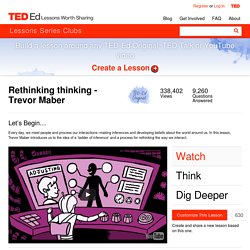
Some examples (in addition to the parking lot example) include: someone cutting in front of you in a line at the store; a friend or family member who is always annoyingly late; or someone who leaves you disappointed because he/she breaks more promises than he/she keeps. As you each share your experience, focus on what assumptions are at play, the conclusions you are each drawing from those assumptions, and what emotions you feel as a result.
The Ladder of Inference. Have you ever found yourself perplexed at the way someone else has interpreted something you said or did, and put a meaning on it that you never intended? Or perhaps you have found yourself enraged by someone’s comment or action, and concluded that they must be acting against you for some reason?